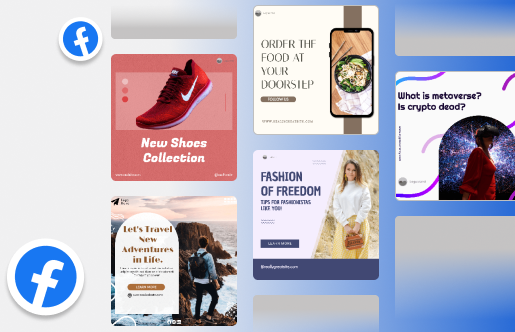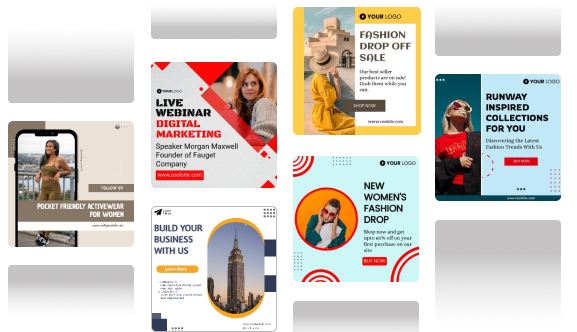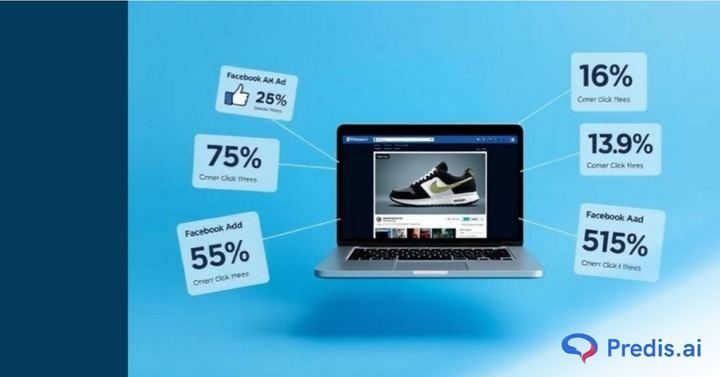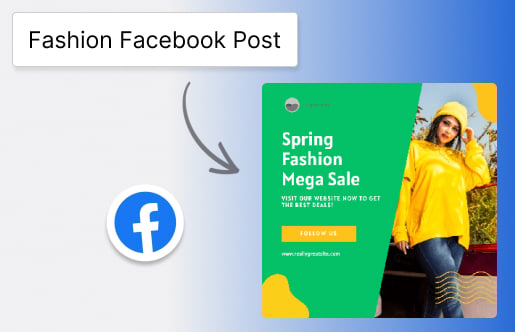Facebook advertising plays an important role in helping businesses reach their target audience, increase brand visibility, and drive conversions. With over 3 billion monthly active users, Facebook remains one of the most powerful advertising platforms, providing businesses with access to a diverse and engaged audience.
Facebook Ads allow marketers to create highly targeted campaigns based on demographics, interests, behaviours, and location. Whether a business aims to increase website traffic, generate leads, or boost sales, Facebook’s advertising platform provides extensive tools to optimise facebook ad performance and maximise return on investment (ROI).
Why Understanding Facebook Ad Statistics is Crucial
The success of any advertising campaign depends on data-driven decisions. This is where Facebook ad statistics become essential. Analysing ad performance metrics helps businesses:
- Understand audience behaviour – Knowing how users interact with Facebook ads enables marketers to refine their targeting strategies.
- Optimise ad spend – Understanding cost-related metrics like cost-per-click (CPC) and cost-per-thousand impressions (CPM) ensures that businesses allocate their budget efficiently.
- Improve engagement and conversion rates – Data on click-through rates (CTR) and conversions help choose the most effective ad formats and content strategies.
- Stay ahead of trends – Digital marketing is constantly evolving, and being aware of Facebook ad types and trends helps businesses stay competitive.
Overview of Facebook Advertising
What is Facebook Advertising, and How Does It Work?
Facebook advertising is a paid digital marketing strategy that allows businesses to display targeted ads to users across Facebook and its associated platforms, including Instagram, Messenger, and the Audience Network. The Facebook Ads Manager platform provides advertisers with tools to create, manage, and track their campaigns, ensuring they reach the right audience with the most effective message.

Facebook Ads work on a bidding system, where advertisers set a budget and bid for ad placements based on their objectives. Businesses can choose from several ad objectives, such as:
- Brand awareness – Increasing visibility among potential customers.
- Traffic – Driving visitors to a website or landing page.
- Engagement – Boosting likes, comments, shares, and interactions.
- Lead generation – Collecting user details for potential sales.
- Conversions – Encouraging users to take specific actions, such as making a purchase or signing up for a service.
To maximise efficiency, Facebook uses an advanced algorithm and machine learning to analyse user behaviour, preferences, and interactions. This enables advertisers to target users based on demographics, interests, location, device usage, and online activity.
Why Businesses Use Facebook Ads for Marketing
With Facebook’s massive audience and advanced targeting capabilities, it has become one of the most effective platforms for online advertising. Businesses choose Facebook Ads for several reasons:
- Unmatched Audience Reach – With billions of active users, Facebook provides businesses access to a diverse and engaged global audience.
- Highly Customisable Targeting – Advertisers can refine their audience based on age, gender, location, interests, and behaviour, ensuring ads reach the most relevant users.
- Cost-Effective Advertising – Compared to traditional advertising, Facebook Ads offer affordable pricing with flexible budget options. Advertisers can start with as little as a few pounds per day and scale as needed.
- Variety of Ad Formats – Facebook offers multiple ad formats, including image ads, video ads, carousel ads, and interactive Stories, allowing businesses to showcase their products creatively.
- Robust Performance Tracking – Businesses can measure ad success using key Facebook ad statistics such as click-through rate (CTR), cost-per-click (CPC), and conversion rates, helping them refine strategies for better results. For automated analytics tracking, consider using an ELT Facebook Ads connector, which extracts hundreds of metrics from Meta accounts in just minutes.
- Integration with Other Marketing Strategies – Facebook Ads can work alongside email marketing, SEO, and content marketing to create a comprehensive digital marketing strategy.
The Impact of Facebook’s Massive User Base
Facebook remains the largest social media platform, making it a powerful tool for businesses to connect with potential customers. Some key statistics highlight its dominance in digital advertising:
- 3.05 billion monthly active users as of 2024.
- Over 200 million businesses use Facebook to engage with their audience.
- More than 10 million advertisers actively run campaigns on Facebook.
- The average Facebook user spends 33 minutes per day on the platform.
This vast audience base ensures that businesses of all sizes, from small startups to global corporations, can effectively reach and engage their target customers through Facebook Ads.
Key Facebook Ad Statistics in 2025
In 2025, Facebook continues to be a dominant force in the digital advertising landscape. Understanding the latest Facebook ad statistics is essential for businesses aiming to optimise their marketing strategies. Below are some critical insights into Facebook’s advertising ecosystem:
Total Number of Active Advertisers on Facebook
As of 2025, Facebook boasts a substantial number of active advertisers across its platforms. This vast pool of advertisers underscores the platform’s effectiveness in reaching diverse audiences and achieving various marketing objectives.
Facebook’s Global and Regional Audience Reach
Facebook’s extensive global presence makes it a valuable tool for businesses targeting both international and local markets. Key statistics include:
- Global Reach: As per Hootsuite, Facebook has approximately 3.05 billion monthly active users worldwide, accounting for a significant portion of the global population.
- Regional Insights:
- Asia-Pacific: This region represents a substantial portion of Facebook’s user base, with millions of active users engaging with the platform daily.
- Europe: European countries collectively contribute a significant number of users, making it a crucial market for advertisers.
- North America: With a high penetration rate, North America remains a key region for Facebook advertising efforts.
- Asia-Pacific: This region represents a substantial portion of Facebook’s user base, with millions of active users engaging with the platform daily.
Average Daily and Monthly Active Users on Facebook
User engagement remains robust on Facebook:
- Daily Active Users (DAUs): Facebook records approximately 2.11 billion daily active users, indicating a steady growth rate of around 5.1% year-over-year.
- Monthly Active Users (MAUs): The platform maintains a strong monthly user base, with millions logging in to interact with content, connect with others, and engage with businesses.
This consistent user activity provides a fertile ground for advertisers to reach potential customers effectively.
Facebook’s Dominance in the Social Media Advertising Market Compared to Other Platforms
In the competitive landscape of social media advertising, Facebook maintains a leading position:
- Advertising Revenue: Facebook’s worldwide ad revenues are projected to reach $116.53 billion in 2025, positioning it second only to Alphabet (Google’s parent company) in digital ad revenue rankings.
- Platform Preference: Among pay-per-click (PPC) marketers, Facebook is a top choice, with 76% utilising the platform for advertising campaigns.
These statistics underscore Facebook’s pivotal role in digital marketing strategies and its continued appeal to advertisers seeking effective engagement with target audiences.
Facebook Ad Engagement Statistics
Understanding Facebook ad statistics is essential for businesses aiming to optimise their advertising strategies. Key engagement metrics such as click-through rates (CTR), engagement rates, and ad format performance provide valuable insights into user interaction and campaign effectiveness.

Average Click-Through Rate (CTR) for Facebook Ads
The click-through rate (CTR) measures the percentage of users who click on an ad after viewing it. While CTR can vary across industries and ad objectives, recent data indicates that approximately 27% of Facebook ads focus on conversions, 24% aim for post engagement, and 23% are optimised for link clicks.
Average Engagement Rate on Different Ad Formats
Engagement rate encompasses user interactions such as likes, comments, and shares. The average engagement rate on Facebook varies by industry. For instance, the technology sector experiences an average engagement rate of 3.1%, while the utilities and energy sector sees a higher rate of 4.0%.
Performance Comparison: Image Ads vs. Video Ads vs. Carousel Ads
Different ad formats yield varying engagement levels:
- Image Ads: These are simple and effective for conveying messages quickly.
- Video Ads: Videos often lead to higher engagement due to their dynamic nature.
- Carousel Ads: Allowing multiple images or videos in a single ad, carousels can showcase various products or features, encouraging users to interact more.
Insights on User Interaction with Facebook Ads
User interaction with Facebook ads is influenced by several factors:
- Relevance: Ads tailored to user interests and behaviours tend to receive higher engagement.
- Ad Placement: Ads appearing in users’ news feeds often achieve better visibility and interaction compared to those in sidebars.
- Content Quality: High-quality visuals and compelling copy are crucial for capturing attention and encouraging engagement.

Facebook Ad Cost Statistics
Understanding Facebook ad statistics is vital for businesses aiming to optimise their advertising budgets and strategies. Social media marketing metrics such as cost-per-click (CPC), cost-per-thousand impressions (CPM), and factors influencing these costs can significantly impact the effectiveness of your campaigns.
Average Cost-Per-Click (CPC) on Facebook Ads
The cost-per-click (CPC) represents the amount an advertiser pays each time a user clicks on their ad. As of June 2024, the average CPC for Facebook ads targeting users in the United States was approximately $0.52. However, this figure can vary significantly across different industries. For example:
- Software Industry: Average CPC of $0.85.
- Food Industry: Average CPC of $0.18.
These variations highlight the importance of industry-specific considerations when planning your Facebook advertising budget.
Average Cost-Per-Thousand Impressions (CPM)
The cost-per-thousand impressions (CPM) indicates the cost an advertiser incurs for every 1,000 views of their ad. In 2024, the average CPM for Facebook ads was reported at $5.61. This rate is slightly lower than the general average CPM for social media ads, which stood at $6.06 in the fourth quarter of 2023
Factors Affecting Facebook Ad Costs
Several factors influence the cost of Facebook ads, including:
- Industry: Different sectors experience varying ad costs due to competition levels and audience engagement. For instance, the technology sector often faces higher advertising costs compared to the education sector.
- Audience Targeting: Narrowing your target audience can lead to higher costs due to increased competition for specific demographics. Conversely, broader targeting may reduce costs but could also lower engagement quality.
- Competition: High demand for ad space within a particular industry or demographic increases costs. Businesses competing for the same audience will drive up bid prices.
- Ad Placement and Format: Costs can vary depending on where your ad appears (e.g., news feed vs. sidebar) and the format used (e.g., image vs. video ads). Video ads, for example, have been noted for their cost-effectiveness, with some reports indicating an effective CPC as low as $0.18
Cost Comparison: Facebook Ads vs. Google Ads vs. Instagram Ads
When evaluating advertising platforms, it’s essential to consider cost differences:
Facebook Ads: Average CPC of $0.52 and CPM of $5.61.

These comparisons underscore Facebook’s position as a cost-effective platform for digital advertising, offering competitive rates that can be particularly advantageous for businesses with limited marketing budgets.
Google Ads: The average CPC for Google Ads is approximately $1.16, nearly double that of Facebook Ads.

Instagram Ads: As part of the Meta family, Instagram often shares similar advertising costs with Facebook. However, specific CPC and CPM values can vary based on factors like audience demographics and ad placement.

How to Use Facebook Ad Statistics
Using Facebook ad statistics is essential for refining your marketing strategy and achieving optimal results. By analysing data on ad formats, costs, audience behaviour, and campaign performance, businesses can make informed decisions to enhance their advertising efforts.
Choosing the Right Ad Format Based on Statistics
- Selecting the appropriate ad format is crucial for engaging your target audience effectively. Facebook offers various ad formats, including image ads, video ads, carousel ads, and lead ads.
- Understanding the performance metrics associated with each format can guide your choice. For instance, video ads often capture higher engagement rates due to their dynamic nature.
- Analysing past campaign data helps identify which formats resonate most with your audience, enabling you to allocate resources to the most effective ad types.
Budget Allocation Based on CPC and CPM Data
- Efficient budget allocation is vital for maximising return on investment (ROI). Key metrics such as cost-per-click (CPC) and cost-per-thousand impressions (CPM) provide insights into the financial efficiency of your ads.
- By examining these statistics, you can identify which campaigns deliver the best value. For example, if a particular ad set has a lower CPC and higher conversion rate, it may warrant increased budget allocation.
- Regularly reviewing CPC and CPM data ensures that your spending aligns with campaign performance, allowing for strategic adjustments to enhance cost-effectiveness.
Improving Ad Performance Through A/B Testing
- A/B testing, or split testing, involves running multiple versions of an ad to determine which elements perform best. By systematically varying components such as headlines, images, ad copy, and calls-to-action, you can gather data on what resonates most with your audience.
- This empirical approach allows for data-driven decisions, leading to improved engagement and conversion rates.
- Continuous A/B testing and analysis of the results enable ongoing optimisation of your ad content, ensuring that your campaigns remain effective and relevant.
Understanding Audience Data for Better Targeting
- Facebook provides comprehensive audience insights, including demographics, interests, behaviours, and engagement patterns.
- Utilising this data allows for precise targeting, ensuring that your ads reach individuals most likely to be interested in your products or services.
- For instance, if statistics reveal that a significant portion of your engaged audience falls within a specific age group or shares particular interests, you can tailor your ad content and targeting parameters accordingly.
- Effective use of audience data enhances the relevance of your ads, leading to higher engagement and conversion rates. Incorporating AI for data analysis enables marketers to test and optimize creatives based on deep insights.
Measuring and Optimising Ad Campaigns With Insights from Facebook Analytics
- Facebook Analytics offers a suite of tools to monitor and evaluate the performance of your ad campaigns.
- Key performance indicators (KPIs) such as reach, engagement, conversion rates, and return on ad spend (ROAS) provide a comprehensive view of your campaign effectiveness. Regular analysis of these metrics enables you to identify successful strategies and areas needing improvement.
- For example, if certain ads exhibit higher engagement but lower conversion rates, you may need to refine your call-to-action or landing page experience.
- By continuously measuring and optimising based on analytics, you can enhance the overall performance and ROI of your Facebook advertising efforts.

Conclusion
Facebook advertising remains one of the most powerful tools for businesses looking to reach a vast and engaged audience. By using Facebook ad statistics, marketers can make data-driven decisions to optimise their campaigns, improve engagement, and increase conversions.
Key Takeaways from Facebook Ad Statistics
- Massive User Base – With billions of active users, Facebook provides unmatched audience reach.
- Ad Engagement Trends – Video ads and carousel ads tend to perform better in terms of engagement and interaction.
- Cost and ROI Considerations – Understanding CPC and CPM helps allocate ad budgets effectively.
- Conversion Optimisation – A/B testing, retargeting, and audience segmentation enhance ad performance.
For marketers and businesses, success in Facebook advertising is not just about running ads, it’s about understanding the data behind them. By making informed decisions based on statistics, simply like using facebook ad maker can refine their strategies, improve targeting, and drive sustainable growth.
By consistently using insights from Facebook ad statistics, businesses can achieve better engagement, higher conversions, and ultimately, greater success in their digital marketing efforts.
You May Also Like,
















